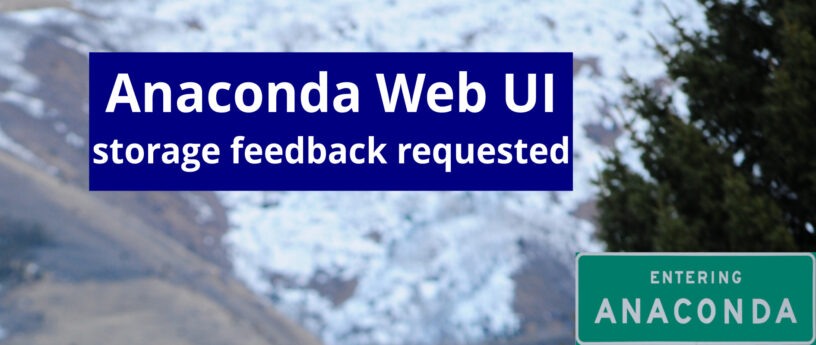As you might know, the Anaconda Web UI preview image has a simple “erase everything” partitioning right now because partitioning is a pretty big and problematic topic. On one hand, Linux guru people want to control everything; on the other hand, we also need to support beginner users. We are also constrained by the capabilities of the existing backend and storage tooling and consistency with the rest of Anaconda. Anaconda team is looking for your storage feedback to help us with design of the Web UI!
In general, partitioning is one of the most complex, problematic, and controversial parts of what Anaconda is doing. Because of that and the great feedback from the last blog, we decided to ask you for feedback again to know where we should focus. We’re looking for feedback from everyone. More answers are better here. We’d like to get input if you’re using Fedora, RHEL, Debian, OpenSUSE, Windows, or Linux, even if it’s just for a week. All these inputs are valuable!
Please help us shape one of the most complex parts of the Anaconda installer!
With just a few minutes of your time filling out the questionnaire, you can help us decide which path we’d like to choose for partitioning.
Questionnaire link: https://redhatdg.co1.qualtrics.com/jfe/form/SV_87bPLycfp1ueko6






Joao Carvalhinho
Answered already… good idea.
Background: Long time light user. NEver made the conversion to Linux until F37 came out.
Dont understand a thing about a partition… but having to test out one or two distros before picking one here is what I would love to have
Option1- Default (I don’t even want to know what is happening)
Option2- Keep my work and files safe! (stores /home in a different partition, encription is an option) *
Option3- I want to configure everything (goes to the full partition thing, that I don’t have knowledge to give opinions)
*on option 2 if it is a new install, jut creates the new partition, if it already exists it should look for the “/home” folder and keep it.
Notice that if a user is upgradin the distro this would be unecessary, but if you distrohop it is great to have this.
Andre Gompel
Great Idea.
Why don’t you mention where to get the ISO file of the live distro with this version of anaconda , ideally MATE or XFCE (latest), because.
A.G
Leslie Satenstein
I am a 10-year Fedora bigot. I started with Red Hat some 22+ years ago as a hobby Linux user. I have enjoyed the use of every version of Fedora since “core”.
There are some things about the web interface that I believe needs to be there as an understanding. That is,
Select and confirm that there is ample “writable” space on the target device
A flashdrive must be present or the ISO stored at a client specified location on his computer.
The web interface has to ensure that the selected ISO is successfully downloaded (checksummed) and subsequently installed to the flash drive.
It has to temporarily, or other, have the computer select the flash drive as the boot partition. (just handle the main cases for now, worry about exceptions for Fedora xx)
Once the flash drive boots, it has to restore the host system to pre-temporary status.
The option to add software categories (a la group install xxxx ) as a series of
[x] Groupabc # gnome
[ ] Groupdef # kde
[ ] Groupghi # games
o-o-o-o-o=o-o-o-o-o
Some decisions which you may have already made are about logon and password.
Grandpa Leslie Satenstein, Montreal,Que
I did complete the survey/questionaire, but there was little room for comments.
You may need a two tiered approach.
Normal user and advanced user.
For the latter, we advanced user types can wait until you have polished the “normal user” web interface.
Timothée Ravier
Suggestion for the next survey: Please avoid phrasing questions answers with a double negative. It makes it really hard to answer correctly as I have to double think about the meaning of my answer.
Example: I don’t need X. Agree/Disagree
Here Agree (positive) means that I don’t like X
Disagree (negative) means that I don’t don’t like X, thus I like X.
It’s harder to answer and easy to misunderstand.
Jonathan
Nice survey to complete, not bad options from Joao as I thought similar things
In my case as an intermediate user and having to install and reinstall and reinstall Fedora a couple of times and then trying other distros’ installers, why don’t include something like Calamares or Debian installers? Anyone thinks the same?
Jesper
Hi, I have tried your new installer and I really like it. However, I hope you will reuse elements from the latest version of Anaconda in Fedora 37 and Fedora 38 Rawhide….It has a nice look and feel to it so I hope you are planning to reuse alot of that look, so it is not only a white background. I really like the new step-by-step/flow based installer, as that will make it easier for people to install Fedora. I think you should consider to offer two entries to the installer, a Default/Basic/Express install button and an Advanced/Custom installer button where the user will go through more steps and can customize more advanced settings, e.g. set the system up as an immutable system. I have suggested it a few weeks back. I think it could be nice to merge all these options into the installer so that everybody downloads the same Fedora Workstation iso and when they click the installer icon on the GNOME desktop in the Fedora Workstation live system they are first met with the two buttons where they can choose between the default/basic installer and the advanced/customize installer by clicking one of the two buttons. You could also make two radio buttons and the one button named OK or Accept. The title of this first window could be e.g. Select Install Method or Select Install Type (or Mode). It does not have to be the first install window. It could also be a later step after the user has chose language, Keyboard, date and Time Zone which would be the same for default and advanced installation. It is basically the same as placing Automatic Partitioning in the Default/Express Mode and Custom Partitioning in the Advanced/Custom Installation Method. If people choose the Advanced/Custom Installation radio button then they could next select from a new radio button if they want to customize the partitions for a default, non immutable way (as in Default/Express Install Method) or if they want to partition the disk as an immutable system, which basically means the user should not be able to modify the partitions and it will be automatically partitioned in the same way as in Fedora Silverblue and Kinoite. The next step should be a window with a title like: Select Desktop Environments. In this window the user should be presented with a list of all available Desktop environments. By default GNOME is ticked, but if the user wants to install additional desktop environments they can tick these in the checkboxes or untick if they don’t want to install GNOME and only want e.g. KDE Plasma or Cinnamon or both. If the user chose to partition and install Fedora as an immutable system the software packages for GNOME and other packages will be downloaded during the installation from the Silverblue repositories which will be set as the default repositories instead of the standard Fedora Workstation repositories. If the user chooses both GNOME and KDE Plasma the transactional image will be downloaded from both the Kinoite and Silverblue repositories. If the user is not choosing to install the system as an immutable system during the Advanced Custom installation, the GNOME packages from the Fedora Workstation iso file will be installed as they would be on Fedora Workstation and updated and if the user selects additional desktop environments these desktop environments will simply be installed from the Fedora Spins repositories. I think it is worth considering to make the new installer an entry point, or a portal, to install fedora from different Fedora Repositories. I am fully aware that Fedora Silverblue/Kinoite requires that the disk is partitioned completely different from a normal partitioning and that updates are delivered in a completely different way. But since Fedora Workstation (and the Fedora Spins) and Fedora Silverblue are using the same Anaconda installer (though with some modifications) I think it would be worth considering to merge everything together into the new installer, perhaps so that users can no longer download separate Fedora Silverblue and Kinoite iso images. Instead, if they want to install Fedora as an immutable system they download the Fedora Workstation or Fedora Netinstaller iso and choose Advanced/Custom install and then in the next window they can select Immutable Mode (by clicking a radio button). I am saying this also to make it easier for you, so you don’t have to spend time making so many iso files for Fedora Spins and for Silverblue/Kinoite and can focus on improving and optimizing Fedora in other ways. Are you considering to make a specific Desktop Environment container for the immutable Fedora (Silverblue/Kinoite)? Maybe that would be a good idea to get further separation of the desktop environments. So that there is one immutable core that is the same for all installations, but some people might want to install more than one desktop environment so maybe that is a solution that is technically possible ? It seems that it is currently only possible to get a KDE Plasma (Kinoite) and GNOME desktop (Silverblue). Maybe later on it would also be possible to install Mate, Cinnamon, Xfce etc. as immutable desktop environments on Fedora. So as I see it you could have one immutable core that does not contain any Desktop environment and then a separate immutable container where the chosen desktop enviroment(s) is/are installed. Since different users install different desktop environments these containers and therefore the size of the images will vary, so therefore that is a custom immutable image. I am not so familiar with immutable systems yet and therefore it is still unclear to me what is technically possible. However, I hope it makes sense and that you can see what I am aiming to achieve with these suggestions. I hope you can use some of my suggestions and I look forward to follow the development of the new Anaconda installer. It is up to you if people should be able to select additional desktop environments in the Default/Express Installation Mode, I guess they should not and only GNOME should be installed. If they want to add more desktop environments they can then choose Advanced/Custom install mode…that would make more sense I guess.
Rimko
If Anaconda installer can manage what I acheive manually on my laptop.
2 SSD of same size, 2 boot in raid 1 partitions, (on each) who can boot to the brfs raid 1 whit encryption.
If on SSD fail I still use my laptop.